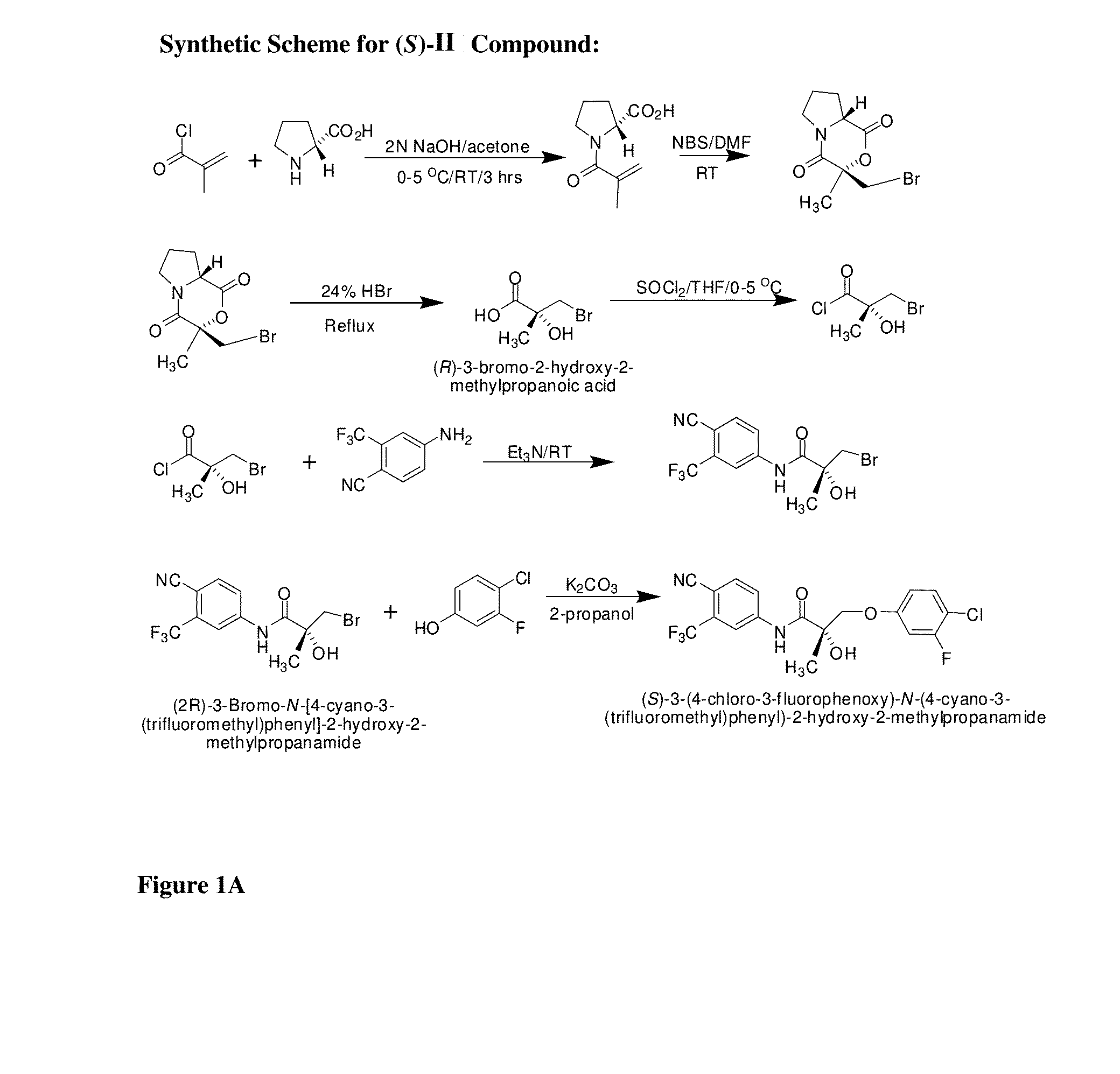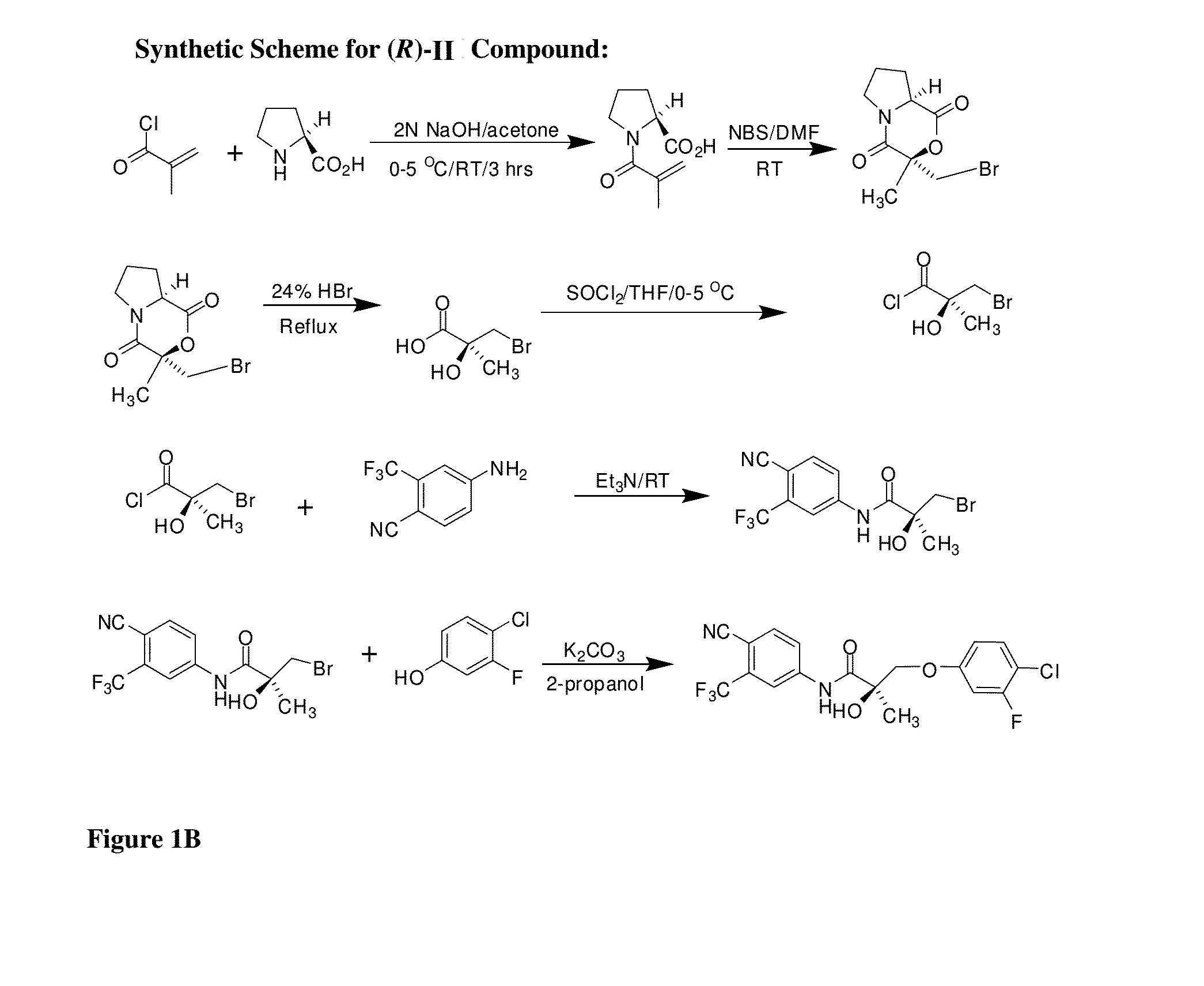Sarms and method of use thereof
a technology of acylanilide and sarms, which is applied in the field of substitution of acylanilide compounds, can solve the problems of muscle wasting, muscle wasting, muscle wasting, etc., and achieve the effects of increasing lean mass, increasing lean mass, and increasing lean mass
- Summary
- Abstract
- Description
- Claims
- Application Information
AI Technical Summary
Benefits of technology
Problems solved by technology
Method used
Image
Examples
example 1
Synthesis of (S) Enantiomer of Compound of Formula II (S-II)
[0424]
(2R)-1-Methacryloylpyrrolidin-2-carboxylic Acid
[0425]D-Proline, 14.93 g, 0.13 mol) was dissolved in 71 mL of 2 N NaOH and cooled in an ice bath; the resulting alkaline solution was diluted with acetone (71 mL). An acetone solution (71 mL) of methacryloyl chloride (13.56 g, 0.13 mol) and 2 N NaOH solution (71 mL) were simultaneously added over 40 min to the aqueous solution of D-proline in an ice bath. The pH of the mixture was kept at 10-11° C. during the addition of the methacryloyl chloride. After stirring (3 h, room temperature), the mixture was evaporated in vacuo at a temperature at 35-45° C. to remove acetone. The resulting solution was washed with ethyl ether and was acidified to pH 2 with concentrated HCl. The acidic mixture was saturated with NaCl and was extracted with EtOAc (100 mL×3). The combined extracts were dried over Na2SO4, filtered through Celite®, and evaporated in vacuo to give the crude product a...
example 2
Metabolic Stability of the Compounds of this Invention
[0432]Metabolic stability assays were performed in order to assess the in vitro half-life of the S-isomer of the compound of formula II (S-II) when incubated with human liver microsomes. The data generated was transformed to determine intrinsic clearance values. In a separate experiment, permeability across human, intestinal epithelial monolayers (Caco-2 cells) was used as a measure of intestinal permeability as well as an indicator of efflux potential. Caco-2 cells are often used as an early screening surrogate for oral bioavailability. Microsomal half-life can be converted to in vitro clearance values as a means to predict hepatic intrinsic clearance. Intrinsic clearance is defined as the functional ability of the liver to metabolize a drug or other compound.
Materials and Methods:
Metabolic Stability Measured in Human Liver Microsomes:
[0433]Compound of formula S-II in this study was incubated at a final concentration of 0.6 μM. ...
example 3
Androgen Receptor Binding Affinity of SARMs
Materials and Methods:
[0440]The androgen receptor (AR) binding affinity of SARMs was determined by using an in vitro competitive radioligand binding assay with [17α-methyl-3H]-mibolerone ([3H]MIB, PerkinElmer), a high affinity AR ligand. Recombinant androgen receptor ligand binding domain (AR LBD) was combined with [3H]MIB in buffer A (10 mM Tris, pH 7.4, 1.6 mM disodium EDTA, 0.26 M sucrose, 10 mM sodium molybdate, 1 mM PMSF) to determine the equilibrium dissociation constant (Kd) of [3H]MIB. Protein was incubated with increasing concentrations of [3H]MIB with and without a high concentration of unlabeled MIB in order to determine total and non-specific binding. Non-specific binding was then subtracted from total binding to determine specific binding and graphed using SigmaPlot and non-linear regression for ligand binding curve with one site saturation to determine the Kd of MIB (1.84 nM). In addition, the concentration of [3H]MIB required...
PUM
| Property | Measurement | Unit |
|---|---|---|
| temperature | aaaaa | aaaaa |
| particle size | aaaaa | aaaaa |
| particle size | aaaaa | aaaaa |
Abstract
Description
Claims
Application Information
 Login to View More
Login to View More - R&D
- Intellectual Property
- Life Sciences
- Materials
- Tech Scout
- Unparalleled Data Quality
- Higher Quality Content
- 60% Fewer Hallucinations
Browse by: Latest US Patents, China's latest patents, Technical Efficacy Thesaurus, Application Domain, Technology Topic, Popular Technical Reports.
© 2025 PatSnap. All rights reserved.Legal|Privacy policy|Modern Slavery Act Transparency Statement|Sitemap|About US| Contact US: help@patsnap.com



